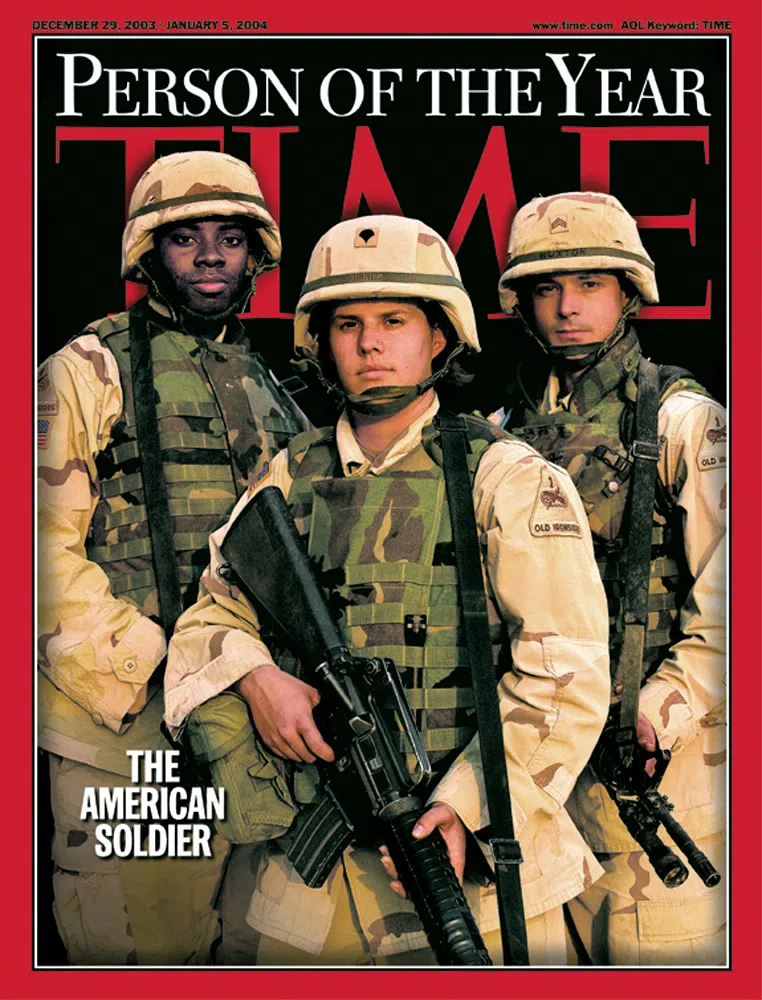
Time Magazine's cover for the Dec. 29- Jan. 5 issue shows three American military personnel representing the "Anonymous American Soldier" chosen by Time to be the magazine's 2003 Person of the Year. (AP Photo/Time)
Time Magazine’s “Person of the Year” is a prestigious accolade that has been awarded annually since 1927. This tradition began as a reflection of the individual or group who had the most significant impact on world events, for better or worse, during the year. Over the decades, the title has evolved to encompass a wide range of influential figures, from political leaders to activists, artists, and even movements. This year’s pick will be announced Wednesday, 12/6. The short list includes Xi Jingping, Trump prosecutors, Vladimir Putin, and Barbie (among others).
The Origin of Time’s Person of the Year:
The concept of naming a “Man of the Year” was first introduced by Time Magazine’s founder and editor-in-chief, Henry Luce. The inaugural title was bestowed upon Charles Lindbergh in 1927, following his historic solo flight across the Atlantic Ocean. The idea was to recognize individuals who had left an indelible mark on the global landscape, shaping the course of history in the process.
Evolution of the Title:
In 1999, Time Magazine updated the title to “Person of the Year,” a change that aimed to be more inclusive and reflect the evolving nature of society. This modification allowed the recognition of groups, movements, and sometimes even ideas that had profoundly impacted the world.
Iconic Picks Over the Years:
1. Franklin D. Roosevelt (1932, 1934, 1941)
One of the rare three-time recipients of the title, Franklin D. Roosevelt, was recognized for his leadership during critical periods in history. In 1932, he inherited a nation grappling with the Great Depression and implemented the New Deal to stimulate economic recovery. In 1934 and 1941, Roosevelt received the honor again, acknowledging his ongoing efforts to navigate the country through challenging times, including World War II.
2. Mahatma Gandhi (1930)
In 1930, Time Magazine chose Mahatma Gandhi as the Person of the Year. This pick underscored Gandhi’s role in leading the Salt March, a pivotal event in India’s struggle for independence from British rule. Gandhi’s philosophy of nonviolent resistance left an enduring impact, not only on India but on global movements advocating for civil rights and social justice.
3. Martin Luther King Jr. (1963)
Martin Luther King Jr. was named Person of the Year in 1963, a year marked by the peak of the civil rights movement in the United States. King’s advocacy for racial equality and his leadership in the March on Washington, where he delivered his iconic “I Have a Dream” speech, made him a central figure in the fight against racial discrimination.
4. The Apollo 8 Astronauts (1968)
In 1968, a year marred by political and social turbulence, Time Magazine chose the three astronauts of Apollo 8—Frank Borman, Jim Lovell, and William Anders. This pick reflected the historic nature of their mission, becoming the first humans to orbit the moon. The image of Earthrise, captured by Anders during the mission, became an iconic symbol of humanity’s place in the cosmos.
5. The American Soldier (2003)
In the aftermath of the September 11, 2001 terrorist attacks, the Person of the Year designation in 2003 went to “The American Soldier.” This choice honored the men and women of the United States military who played a crucial role in the ongoing War on Terror, including the invasion of Iraq earlier that year.
6. The Protester (2011)
In 2011, Time Magazine broke from its tradition of featuring an individual and instead chose to recognize a phenomenon: “The Protester.” This nod acknowledged the widespread global movements, such as the Arab Spring and Occupy Wall Street, that were characterized by people taking to the streets to demand political and social change.
Controversial Picks:
While many selections for Person of the Year have been widely accepted, some have sparked controversy and debate. One notable example is Adolf Hitler, who was chosen in 1938. At the time, Hitler’s aggressive expansionist policies were making headlines, but in retrospect, the decision has been criticized for potentially downplaying the atrocities committed by the Nazi regime.
Another controversial selection was Joseph Stalin in 1939 and 1942. Despite his role in the defeat of Nazi Germany, Stalin’s brutal regime and widespread human rights abuses raised questions about the appropriateness of honoring him with such a prestigious title.
Recent Picks:
1. Greta Thunberg (2019)
In 2019, Time Magazine selected Greta Thunberg, a Swedish environmental activist, as the Person of the Year. Thunberg gained international recognition for her efforts to raise awareness about climate change and her advocacy for stronger environmental policies. The choice highlighted the growing urgency of addressing global environmental challenges.
2. Kamala Harris (2020)
In 2020, Kamala Harris made history as the first female, first Black, and first Asian-American Vice President-elect of the United States. Time Magazine recognized her groundbreaking achievement by naming her and President-elect Joe Biden as the joint Persons of the Year, emphasizing their roles in shaping the future of American politics.
Time Magazine’s Person of the Year remains a powerful and influential recognition of those who have left an indelible mark on the world. From political leaders and activists to entire movements, the title reflects the evolving nature of global events and the individuals who shape them. As Time continues to choose figures who have made a significant impact, the Person of the Year serves as a snapshot of the year’s defining moments and the people who have influenced them. Whether celebrating moments of triumph or acknowledging the challenges we face, this tradition continues to be a testament to the magazine’s commitment to recognizing those who have shaped the course of history.